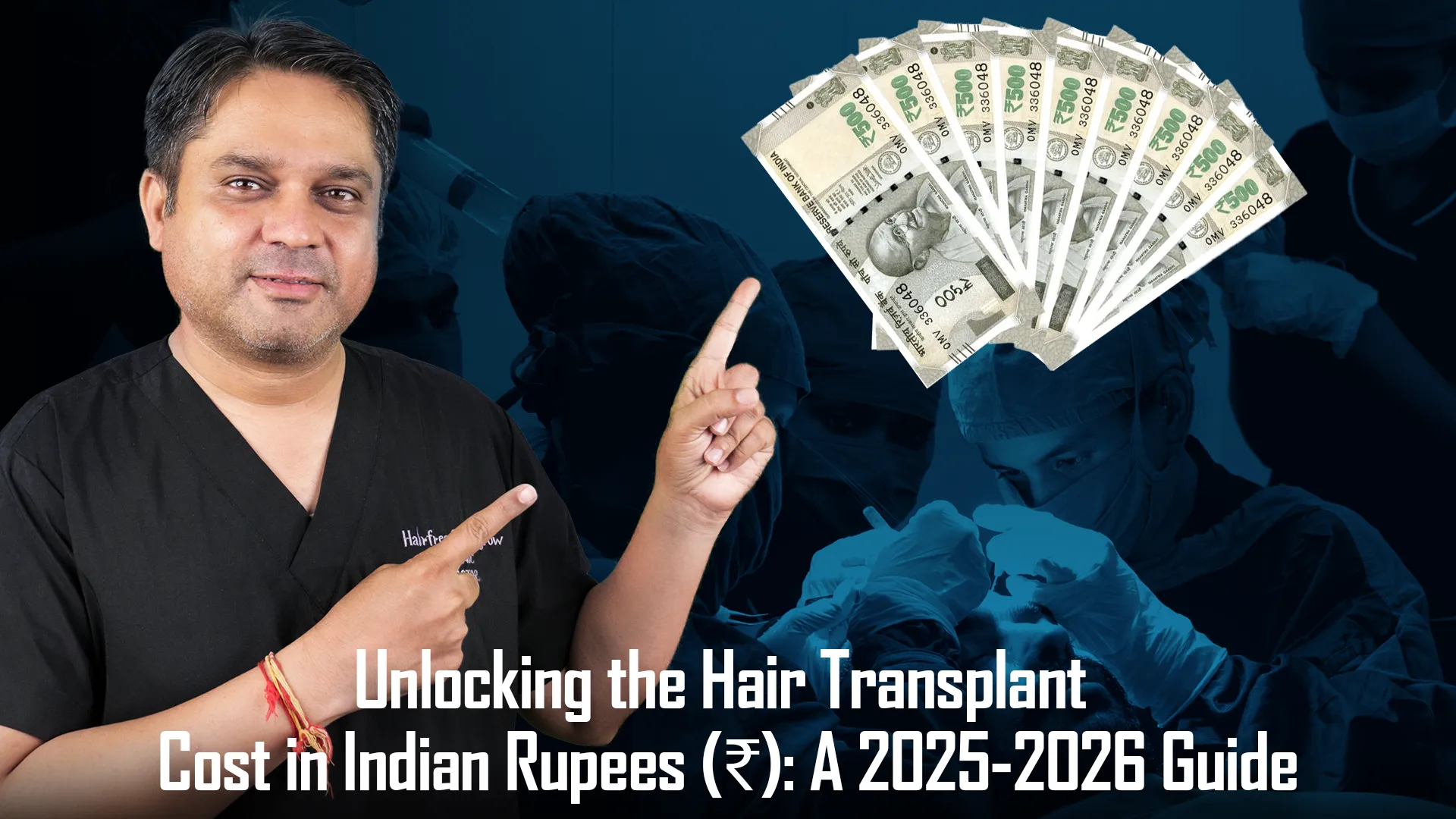One of the most common questions people ask before getting a hair transplant is, “What exactly is a graft?” Many people get confused between the number of hairs and the number of grafts. Some clinics talk about the number of hairs, while others quote the cost based on the number of grafts. This often leads to confusion and a mismatch in cost expectations.
So, in this blog, we’ll explain everything you need to know about grafts in a hair transplant in simple and easy-to-understand English.
What is a Graft in Hair Transplant?
A graft is the most basic unit used in a hair transplant. It refers to a small piece of scalp tissue that contains hair follicles, usually 1 to 4 per graft.
Each graft is carefully harvested from the donor area (typically the back or sides of your head where hair growth is dense and resistant to balding) and then implanted into the recipient area (the part of the scalp with hair thinning or bald spots).
Key point: Grafts are not the same as individual hairs. One graft can contain multiple hair strands. This distinction is important when calculating cost or estimating coverage.
Types of Graft Extraction Techniques (FUT vs. FUE)
Hair grafts can be extracted using two main techniques: FUT (Follicular Unit Transplantation) and FUE (Follicular Unit Extraction).
FUT (Strip Method)
- A strip of scalp is surgically removed from the donor area.
- Grafts are then separated under a microscope.
- Leaves a linear scar but allows for a high number of grafts in one session.
FUE (Punch Extraction)
- Grafts are harvested individually using a micro-punch tool.
- Minimally invasive, no stitches, and leaves tiny dot scars.
- Most popular modern method due to faster healing and less visible scarring.
Each method has its pros and cons, and the right one depends on your hair type, goals, and donor hair availability. Some clinics also offer advanced versions like DHI (Direct Hair Implantation), which is a variation of FUE that minimizes the time grafts stay outside the body.
How Many Grafts Do You Need?
The number of grafts you’ll need depends on several factors:
- Extent of hair loss
- Size of the recipient area
- Hair thickness and texture
- Desired hair density
- Availability of donor hair
Estimated Graft Requirements
Bald Area | Approximate Grafts Needed |
Hairline Restoration | 1,000 – 2,000 grafts |
Front + Mid-scalp | 2,000 – 3,500 grafts |
Full Crown Coverage | 1,500 – 2,500 grafts |
Full Head (High Baldness) | 4,000 – 6,000+ grafts |
Tip: More grafts do not always mean better results. A skilled surgeon focuses on strategic placement, angle, and density.
Cost Per Graft: What Are You Really Paying For?
Hair transplant clinics typically charge per graft. Prices can range from ₹20 to ₹150 per graft in India (or $3–$10 in countries like the US).
Example Calculation
If a clinic charges ₹40 per graft and you need 2500 grafts: Total = ₹40 x 2500 = ₹1,00,000
But beware: cheap isn’t always good. Some low-cost clinics may:
- Split one graft into multiple parts to make it look like you’re getting more
- Reuse tools or compromise hygiene
- Overharvest from the donor area
Ask the clinic whether the cost includes extraction, implantation, post-op care, and graft preservation.
Do Grafts Fall Out After Hair Transplant?
Yes, they do—and it’s perfectly normal!
After a transplant, your implanted hairs will shed within 2–4 weeks. This is called “shock loss.” But don’t worry—the follicles remain underneath and will begin growing new hair after 3–4 months.
You’ll start seeing visible results by 6 months, and full results around 12–15 months post-surgery.
Graft Growth Timeline
- 0–2 weeks: Healing, scabbing
- 2–4 weeks: Shedding phase
- 3–5 months: New hair starts growing
- 6–12 months: Hair thickens and matures
Common Myths About Grafts – Busted!
Let’s clear up some widespread confusion:
Myth 1: “More grafts = better results”
Not always. Success depends on placement, hair angle, density, and how well the grafts survive, not just numbers.
Myth 2: “Grafts don’t survive long outside the body”
While it’s true that time outside the body affects survival, professional clinics ensure grafts are preserved in special storage mediums.
Myth 3: “You can transplant unlimited grafts”
You have a limited donor supply. Overharvesting can lead to patchy donor areas and poor results.
How to Protect and Boost Graft Survival
Your surgeon plays a major role in graft survival, but so do you.
Here’s how to care for your grafts
- Follow post-op instructions strictly
- Avoid touching or scratching the scalp
- Keep your scalp clean and dry
- Sleep with your head elevated for the first few nights
- Avoid heavy workouts, direct sun, or sweating for 1–2 weeks
- Don’t wear hats or helmets until cleared by your doctor
Proper hydration and nutrition also support better healing and hair regrowth.
Conclusion
To sum it up, a hair graft is a complete hair follicle unit taken from the donor area and transplanted into the bald area to give you natural, long-lasting results. Understanding the difference between grafts and hairs will help you make better decisions when consulting with clinics and planning your hair transplant.
If you’re considering a hair transplant, make sure to ask your surgeon how many grafts will be used and how that translates into overall hair density. That’s the best way to set realistic expectations for your result.
Ready to Take the First Step Toward Hair Confidence?
At Hairfree & Hairgrow Clinic, we specialize in advanced hair transplant techniques with natural-looking, long-lasting results. Whether you’re curious about how many grafts you need or want expert guidance tailored to your hair loss stage, we’re here to help.
- 18+ Years of Experience
- Trusted by 1,00,000+ Happy Clients
- Modern Clinics Across 12+ Indian Cities
- Transparent Pricing, Zero Hidden Costs
Book your free consultation today and let our expert team create a customized hair restoration plan just for you.
FAQs
1. How many hairs are there in one graft?
One graft usually contains 1 to 4 hair follicles. So, if you get 2,000 grafts, you’re not getting 2,000 hairs—you could be getting anywhere from 4,000 to 6,000 hairs, depending on your hair’s natural grouping.
2. Is it better to get more grafts for better results?
Not always. It’s more important where and how the grafts are placed. A skilled surgeon can create fuller, natural-looking results with fewer grafts by using proper angles, density, and design. Quality beats quantity in hair transplant success.
3. Do grafts fall out after the transplant?
Yes, and it’s completely normal. The hairs from the transplanted grafts fall out within 2–4 weeks, but the roots stay behind. New hair usually starts growing in 3 to 4 months.
4. Can grafts be reused or moved again later?
No. Once a graft is transplanted, it becomes part of the new site and can’t be moved again. Also, you have a limited donor area, so surgeons must use grafts wisely.
5. How long do transplanted grafts last?
Transplanted grafts are permanent because they’re taken from areas genetically resistant to hair loss. With proper care, they can last a lifetime, but other areas of your scalp may still thin over time, which might require additional treatment later.
Written By
MBBS, DDV
Dr. Nipun Kesarkar is a renowned hair restoration expert specializing in advanced techniques and patient education. He provides clear insights on What Is Graft in Hair Transplant, helping individuals understand the procedure and make informed choices for natural, lasting hair growth.
Disclaimer
We’ve made all possible efforts to ensure that the information provided here is accurate, up-to-date and complete, however, it should not be treated as a substitute for professional medical advice, diagnosis or treatment. See Detailed Disclaimers Here.





